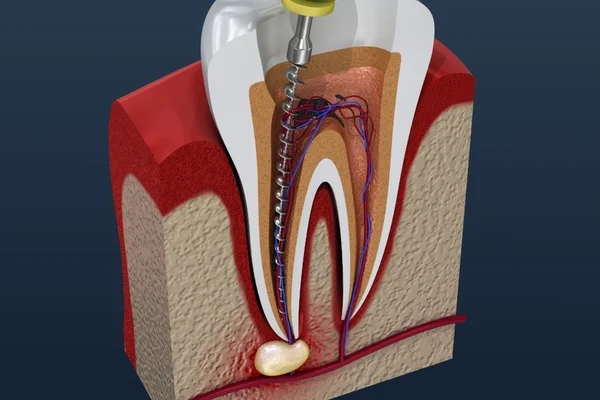
What is Root-Canal Treatments?
Inside the tooth, under the enamel and dentin layers, there is a soft vein-nerve extension (pulp). When the pulp is damaged and inflamed for any reason, root canal treatment should be performed. Procedures performed to treat inflammations are called root canal treatment. Dental canals are very small and thin tunnels that start from the crown of the tooth and continue to the root tip. Root canal treatment is the process of removing the pulp inside these tunnels.In the past, the only treatment for teeth with inflamed pulp was tooth extraction, but today, thanks to root canal treatment, we can keep the teeth in the mouth and ensure that they serve for a long time.
Why Should My Tooth Get Root Canal Treatment?
The main reason for root canal treatment is deep and widespread decay reaching the pulp. When the pulp is damaged and inflamed, it dies because it cannot heal itself. Pulp death occurs most often in a tooth that has been hit, broken, or due to deep decay. In both cases, bacteria reach the pulp and cause inflammation there. In such a case, stimuli such as chewing, pressure, hot and cold can cause extreme sensitivity and pain. In addition, pulp inflammation can cause spontaneous pain that cannot be relieved with painkillers. The purpose of filling root canals is to fill the canal space and create a barrier against microorganisms and tissue fluids. In this way, the tooth can successfully continue its existence in the mouth despite being lifeless.Wouldn’t using antibiotics be enough?
Medicines you take without the dentist’s knowledge – especially antibiotics – can only postpone your pain temporarily. Antibiotics used for a long time make the inflammation more resistant and make it difficult to treat the tooth. If the pulp inflammation is not treated, the accumulation of inflammation at the root tips and jawbone results in “pus-filled sacs” called abscesses. These abscesses that form at the root tips can expand and destroy the bone tissue around the root. If the infected pulp is not removed, pain and swelling will occur. If treatment is not applied for a long time, the tooth may need to be extracted.Are There Alternatives to Root Canal Treatment?
There is no other treatment option that can be an alternative to root canal treatment. In cases where repeat root canal treatment is unsuccessful or in teeth where root canal treatment cannot be applied a second time, surgical intervention can be performed on the root apex of the tooth. In cases where repeat root canal treatment and surgical intervention are unsuccessful or in teeth with excessive material loss and on which filling or coating cannot be applied, extraction should be considered. The gap that will occur after the extraction of the tooth can be treated with a bridge or implant application. However, preserving the natural tooth is always preferred. The loss of one or more teeth can cause the neighboring teeth to shift and deteriorate. In addition, preserving the natural teeth does not require expensive and long treatments such as implants and bridges.Will I Feel Pain During Root Canal Treatment?
Root canal treatment is a treatment that requires patience and dedication from both the doctor and the patient. In cases where it is deemed necessary, anesthesia is applied to the tooth and its surroundings before the treatment. The patient does not feel any pain due to the numbness achieved. Mild pain and sensitivity may be experienced in the tooth after the treatment, but this is temporary. In this case, the best solution is not to use the side where the tooth is located effectively for a few days or to use an anti-inflammatory drug. After a short while, the sensitivity will disappear.Is the Number of Canals Different for Each Tooth?
The incisors and canines located in the front of the mouth usually have 1 root and 1 or 2 canals inside it. The premolars on the side of the mouth usually have 2 roots and 2 or 1 canals. The molars in the upper jaw usually have 3 roots and 3 or 4 canals, while the molars in the lower jaw have 2 roots and 3 or 4 canals. All of these numbers are generalizations. Sometimes it is possible to have additional roots and canals.
How is Root Canal Treatment Performed and How Long Does It Take?
- Local anesthesia: numbing the tooth and surrounding tissues.
- Cleaning tooth decay and opening root canals.
- Determining the canal length by taking radiography (x-ray) or using special devices.
- Cleaning the root canals by removing their contents (pulp tissue).
- Shaping of root canals using a variety of hand and rotary instruments.
- Disinfection of root canals to remove microorganisms.
- Filling of root canals.










